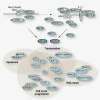Taking the time to make important decisions: the checkpoint effector kinases Chk1 and Chk2 and the DNA damage response
- PMID: 19473886
- PMCID: PMC2725228
- DOI: 10.1016/j.dnarep.2009.04.012
Taking the time to make important decisions: the checkpoint effector kinases Chk1 and Chk2 and the DNA damage response
Abstract
The cellular DNA damage response (DDR) is activated by many types of DNA lesions. Upon recognition of DNA damage by sensor proteins, an intricate signal transduction network is activated to coordinate diverse cellular outcomes that promote genome integrity. Key components of the DDR in mammalian cells are the checkpoint effector kinases Chk1 and Chk2 (referred to henceforth as the effector kinases; orthologous to spChk1 and spCds1 in the fission yeast S. pombe and scChk1 and scRad53 in the budding yeast S. cerevisiae). These evolutionarily conserved and structurally divergent kinases phosphorylate numerous substrates to regulate the DDR. This review will focus on recent advances in our understanding of the structure, regulation, and functions of the effector kinases in the DDR, as well as their potential roles in human disease.
Conflict of interest statement
The authors have no conflicts of interest or financial disclosures.
Figures


References
-
- Ahn J, Urist M, Prives C. The Chk2 protein kinase. DNA Repair (Amst) 2004;3:1039–1047. - PubMed
-
- Kass EM, Ahn J, Tanaka T, Freed-Pastor WA, Keezer S, Prives C. Stability of checkpoint kinase 2 is regulated via phosphorylation at serine 456. J Biol Chem. 2007;282:30311–30321. - PubMed
-
- Gabant G, Lorphelin A, Nozerand N, Marchetti C, Bellanger L, Dedieu A, Quemeneur E, Alpha-Bazin B. Autophosphorylated residues involved in the regulation of human chk2 in vitro. J Mol Biol. 2008;380:489–503. - PubMed
Publication types
MeSH terms
Substances
Grants and funding
LinkOut - more resources
Full Text Sources
Molecular Biology Databases
Miscellaneous

